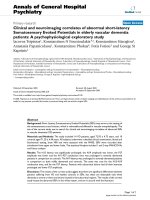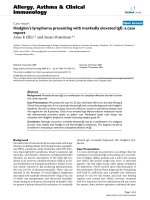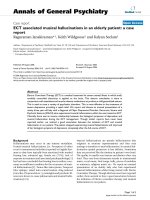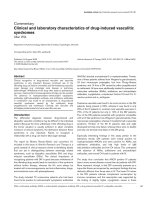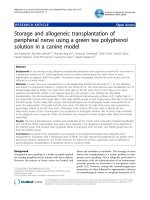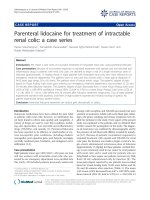Báo cáo y học: "Clinical and histologic features of botryoid odontogenic cyst: a case report" pptx
Bạn đang xem bản rút gọn của tài liệu. Xem và tải ngay bản đầy đủ của tài liệu tại đây (3.89 MB, 4 trang )
CAS E REP O R T Open Access
Clinical and histologic features of botryoid
odontogenic cyst: a case report
Vitor H Farina, Adriana AH Brandão, Janete D Almeida
*
, Luiz AG Cabral
Abstract
Introduction: The lateral periodontal cyst, as the name implies, occurs on a lateral periodontal location and is of
developmental origin, arising from cystic degeneration of clear cells of the dental lamina. A botryoid odontogenic
cyst is consider ed to be a rare multilocu lar variant of a lateral periodontal cyst.
Case presentation: We report the clinical and histopathologic features of a rare case of botryoid odontogenic cyst
found in an edentulous area corresponding to the right lower canine of a 64-year-old African-American woman.
A multilocular radiolucency was observed, and surgical removal of the lesion revealed a nodule of rubber-like
consistency measuring about 1.5 cm in diameter. Cross-sectioning of the nodule showed that it consisted of
various cystic compartments. Histologically, various voluminous periodic acid-Schiff-negative clear cells randomly
distributed throughout the cystic epithelium were observed, as well as cell layers showing thickenings generally
formed by oval, sometimes entangled plaques. The capsule consisted of fibrous connective tissue and showed rare
and discrete foci of a perivascular mononuclear inflammatory infil trate and reactive bone-tissue frag ments. The final
diagnosis was botryoid odontogenic cyst.
Conclusion: We provide data that allow the reader to establish the differences between botryoid odontogenic
cyst, glandular odontogenic cyst, and lateral periodontal cyst, helping with the differential diagnosis. The reader will
have the opportunity to review botryoid odontogenic cyst clinical and histopathologic features, including
treatment.
Introduction
Botryoid odontogenic cyst (BOC) was originally described
in 1973 by Weathers and Waldron [1] as an i ntraoss eous
lesion chara cterized by a macroscopic and microscopic
multilocular growth pattern, resembling a bunch of grapes
(from the Greek word botrios). BOC is considered to be a
variant of a lateral periodontal cyst [2]. Greer and Johnson
[3], reviewing 10 cases of BOC, observed that ni ne of the
lesion s were located in the mandible, mainly the anterior
region, and one in the maxilla, also in the anterior region.
Radiologically, eight cases were characterized by unilocular
radiolucencies, and two, by multilocular radiolucencies.
The mean age of the patients was 46 years. Three cases
were recurrences, one occurring eight year s, an d two, 10
years after treatment. Histologically, non-keratinized squa-
mous epithelium consisting of a few cell layers was
observed, which showed plaque-like thickening in seven
cases. Zones of clear cells scattered throughout the epithe-
lium and containing periodic acid-Schiff (PAS)-positive
material were observed in all 10 cases. In four cases, a dis-
cretely hyalinized zone underlying the basal epithelial layer
was noted. All 10 lesions were characterized by the pre-
sence of multiple cystic compartments.
In a study evaluating 66 cases of BOC, Ramer and
Valuri [4] found a slight predominance in wome n (53%)
over men (47%), with 70% of the cases occurring in
white individuals and 30%, in black individuals. Heikin-
heimo et al. [5] reported a case of BOC with multiple
recurrences that had occurred over a period of nine
years, which led the authors to propose more-radical
surgical intervention in cases of BOC. Manor et al. [6]
stated that BOC frequently shows a lobulated radio-
graphic pattern similar to that of glandular odontogenic
cysts and, there fore, the latter should be included in the
differential diagnosis. However, these cysts are charac-
terized by the presence of salivary gland-like structures
* Correspondence:
Department of Biosciences and Oral Diagnosis, São José dos Campos Dental
School, São Paulo State University-UNESP, São José dos Campos, São Paulo,
Brazil
Farina et al. Journal of Medical Case Reports 2010, 4:260
/>JOURNAL OF MEDICAL
CASE REPORTS
© 2010 Farina et al; license e BioMed Central Ltd. This is an Open Access article distri buted under the terms of the Creative Commons
Attribution License ( which permits unrestricted use, distribution, and reproduction in
any medium, provided the original work is properly cited.
in the lining epithelium, an uncommon histologic find-
ing in BOC [7].
Case presentation
A 64-year-old African-American woman presen ted at
our outpatient clinic with a two-year history of asympto-
matic enlargement in the right anterior region of the
edentulous mandible.
Clinical examination revealed an expansion, measuring
approximately 2 cm in the major diameter and located
in the region corresponding to the right lower canine,
which was of firm consistency on palpation, lined with
intact mucosa, and presented a multi-lobulated surface
(Figure 1a). Occlusal radiography showed a well-delim-
ited multilocular radiolucency in the region of expansion
(Figure 1b). On the basis of these data, the differential
diagnosis of a cyst of odontogenic origin was
established.
Surgical removal of the lesion, which was easily
separated from the surrounding bone, revealed a
nodule of rubber-like consistency measuring about
1.5 cm in diameter (Figure 1c). Cross-sectioning of
the nodule showed that it consisted of various cystic
compartments (Figure 2a). The surgical specimen was
sent for histopathologic analysis, which showed the
presence of multiple cystic cavities of variable size and
shape and thi n walls lined with non-keratinized strati-
fied pavement epithelium of variable thickness; the
epithelium either consisted of a few cell layers or
showed thickenings generally formed by oval, some-
times entangled, plaques (Figure 2b and 2c). In addi-
tion, various voluminous PAS-negative clear cells
randomly distributed throughout the cystic epithelium
were observed (Figure 2d). The capsule consisted of
fibrous connective tissue and rare and discrete foci of
a perivascular mononuclear inflammatory infiltrate
and reactive bone-tissue fragments. The final diagnosis
was B OC.
Discussion
ThecaseofBOCreportedinthepresentstudywas
characterized clinically by an asymptomatic nodule
located in the right anterior region of the mandible, and
radiographically, by a multilocular radiolucent lesion,
reflecting the macroscopic aspect of the surgical speci-
men, a phenomenon not always observed in BOC
because this type of cyst tends to present a unilocular
radiographic aspect [4]. Conversely, the multilocular
radiographic aspect is very frequent in cases of glandular
odontogenic cysts [6]; however, these cysts show glandu-
lar ductlike structures in the lining epithelium, not
observed in this case.
Figure 1 Details of the asymptomatic enlargement. (a) Expansion located in the region corresponding to the right lower canine lined with
intact mucosa and presenting a multi-lobulated surface. (b) Occlusal radiograph showing a well-delimited multilocular radiolucent lesion.
(c) Nodule measuring about 1.5 cm in diameter; it was removed surgically.
Farina et al. Journal of Medical Case Reports 2010, 4:260
/>Page 2 of 4
In the present case, the microscopic observation of
multiple cystic cavities lined wit h non-keratinized strati-
fied pavement epithelium consisting of a few cell layers
with focal entangled thickenings, the presence of volu-
minous clear cells in the epithelium, and a thin connec-
tive tissue capsule with a few inflammatory cells,
combined with the clinical and radiographic findings,
defined the diagnosis of BOC, as also reported by Fal-
cone et al. [8]. The fact that the clear cells present in
the epithelium were not stained with PAS indicates that
they did not contain glycogen or is just an example of
the vagaries of histochemical staining procedures. Nega-
tive findings may well be due to tissue handling or other
technical details. This finding is in contrast to the
results of Greer and J ohnson [3] and Gurol et al. [9],
who observed staining of these cells with PAS. Greer
and Johnson [3] reported a similarity between these
clear cells rich in glycogen, frequently observed in the
epithelium of BOC, and dental lamina cells, suggesting
that the dental lamina is one of the possible origins of
BOC. However, these cells do not seem to exert any
influence on the biologic behavior of the cyst. The diag-
nosis of BOC should not be discarded i n cases of nega-
tive PAS staining when all other histologic features are
present.
With respect to the similarity between BOC and lat-
eral periodontal cysts, Machado de Souza et al. [10] sta-
ted that BOC are distinguished from the latter by their
larger size, which, associated with the multilocular char-
acteristic of BOC, increases the possibility of recurrence
because complete surgical removal becomes more
difficult.
Üçok et al. [2] reported that the ris k of recurrence of
BOC is similar to that of keratocystic odontogenic
tumors, but that the former shows less aggressive
behavior. According to Ramer and Valuri [4], BOC is
not an aggressive lesion, and rec urrences are the result
of conservative surgical treatment (enucleation). The
authors observed that 10 of 13 recurrences studied
presented a multilocular radiographic aspect and
Figure 2 Studies of the cyst. (a) Cross-sectioned nodule showing various cystic compartments. (b) Multiple cystic cavities lined with thin
pavement epithelium with thickened areas (arrows) (H&E, 200×). (c) Plaque-like focal thickening in the epithelial lining of the cyst (arrow) (H&E,
400×). (d) Cystic cavity showing PAS-negative voluminous clear cells in the lining epithelium (arrow) (PAS, 400×).
Farina et al. Journal of Medical Case Reports 2010, 4:260
/>Page 3 of 4
suggested more-frequent postoperative follow-up visits
in these cases.
The case reported here has been followed up for eight
years. So f ar, no clinical or radiographic evidence char-
acterizes recurrence of the lesion, indicating that the
lesion was removed in toto. However, follow-up for a
longer period is necessary to ensure the success of sur-
gical treatment in this case of BOC.
Conclusion
Recurrences of multilocular radiolucent lesions of BOC
are common. A non-conservative surgical removal is the
only effective treatment for this kind of lesion.
Consent
Written informed consent was obtained from the patient
for publication of this case report and accompanying
images. A copy of the written consent is available for
review by the Editor-in-Chief of this journal.
Authors’ contributions
JDA and LAGC analyzed and interpreted the patient data and performed the
surgical procedures. AAHB performed the histologic examination and
photographs. VHF was a major contributor in writing the manuscript. All
authors read and approved the final manuscript.
Competing interests
The authors declare that they have no competing interests.
Received: 7 December 2009 Accepted: 10 August 2010
Published: 10 August 2010
References
1. Weathers DR, Waldron CA: Unusual multilocular cysts of the jaws
(botryoid odontogenic cysts). Oral Surg Oral Med Oral Pathol 1973,
36:235-241.
2. Uçok O, Yaman Z, Günhan O, Uçok C, Dogan N, Baykul T: Botryoid
odontogenic cyst: report of a case with extensive epithelial proliferation.
Int J Oral Maxillofac Surg 2005, 34:693-695.
3. Greer RO Jr, Johnson M: Botryoid odontogenic cyst: clinicopathologic
analysis of ten cases with three recurrences. J Oral Maxillofac Surg 1988,
46:574-579.
4. Ramer M, Valauri D: Multicystic lateral periodontal cyst and botryoid
odontogenic cyst. Multifactorial analysis of previously unreported series
and review of literature. . N Y State Dent J 2005, 71:47-51.
5. Heikinheimo K, Happonen RP, Forssell K, Kuusilehto A, Virtanen I: A
botryoid odontogenic cyst with multiple recurrences. Int J Oral Maxillofac
Surg 1989, 18:10-13.
6. Manor R, Anavi Y, Kaplan I, Calderon S: Radiological features of glandular
odontogenic cyst. Dentomaxillofac Radiol 2003, 32:73-79.
7. Slater LJ: Botryoid odontogenic cyst versus glandular odontogenic cyst.
Int J Oral Maxillofac Surg 2006, 35:775.
8. Falcone F Jr, Lazow SK, Solomon MP, Berger JR: The botryoid odontogenic
cyst: case report and twenty-five year literature review. J N J Dent Assoc
1995, 66 :15-18.
9. Gurol M, Burkes EJ Jr, Jacoway J: Botryoid odontogenic cyst: analysis of 33
cases. J Periodontol 1995, 66:1069-1073.
10. de Souza SO, Campos AC, Santiago JL, Jaeger RG, de Araújo VC: Botryoid
odontogenic cyst: report of a case with clinical and histogenic
considerations. Br J Oral Maxillofac Surg 1990, 28:275-276.
doi:10.1186/1752-1947-4-260
Cite this article as: Farina et al.: Clinical and histologic features of
botryoid odontogenic cyst: a case report. Journal of Medical Case Reports
2010 4:260.
Submit your next manuscript to BioMed Central
and take full advantage of:
• Convenient online submission
• Thorough peer review
• No space constraints or color figure charges
• Immediate publication on acceptance
• Inclusion in PubMed, CAS, Scopus and Google Scholar
• Research which is freely available for redistribution
Submit your manuscript at
www.biomedcentral.com/submit
Farina et al. Journal of Medical Case Reports 2010, 4:260
/>Page 4 of 4
